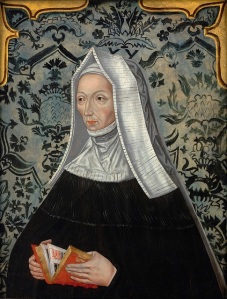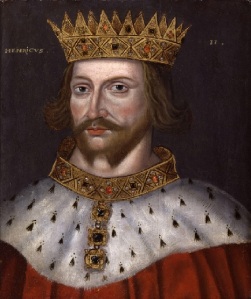On 14th July 1471, Richard Neville, 16th Earl of Warwick, was killed at the Battle of Barnet. It brought to an end the career of a man who was, in his day, the most powerful non-royal noble in the kingdom. Initially loyal to King Henry VI, Warwick began to support the Duke of York following a dispute with the Duke of Somerset. He had control of the garrison at Calais which made him a formidable force. The Calais force was the only standing army in England at the time, the only retained force of trained soldiers in the country. And they were Warwick’s men. When the Duke of York was killed at the Battle of Wakefield, Warwick continued to support his house and was instrumental in seeing Edward IV take the throne from the hapless Henry VI.
Warwick was now the king’s right hand man. Power and offices flowed to him. He began to negotiate a French alliance to be sealed by Edward’s marriage to a French princess. At Council on day, Warwick’s world began to crumble. Imagine the scene as he proudly reported the progress of his negotiations and the almost concluded wedding arrangements, only for Edward to casually announce, in his “Oh, did I forget to mention…” way, that he was already married. He had married a widow considered below him who brought with her children and relatives who were later to prove divisive at Edward’s court. By the standards of his day, the slight upon Warwick’s honour was considerable and he did not take it well. He had lost face before the Council and before the French and he was not the kind of man to allow this to pass.
As tension between the king and his greatest subject grew the threat of a return to civil war gripped the country. Warwick sought out Margaret of Anjou, Henry VI’s wife and, after over half an hour on his knees before her, she agreed to allow him to help place Henry back upon the throne. No doubt Warwick saw an opportunity to control Henry in a way he could never control Edward. Warwick recruited Edward’s brother George, Duke of Clarence to his cause, but his other brother Richard, Duke of Gloucester, who had been raised in Warwick’s household, refused to betray his king. Warwick had two daughters. The eldest he married to George in spite of Edward’s prohibition. The youngest he wed to Henry VI’s son and heir. One way or another, Warwick would have his grandchild upon the throne.
Henry VI emerged from the Tower of London, blinking, bewildered and suddenly king again. Eighteen months later, Edward had regrouped and retook his throne. Barnet was the first engagement in the process and Warwick met his end there aged 42. He was later referred to as The Kingmaker for the way in which he appeared to pick and choose who would be king. This perhaps overstates his achievements on this front. He aided Edward in seizing he throne and then helped Henry regain it, but could not help him retain it, a fact that cost Henry his life when Edward returned to London.
This made me wonder: Who were the other Kingmakers and is there one I would consider The Kingmaker ahead of Warwick? There is, and I fear that I may have to apologise to some for my conclusion, so I shall put it off for a while.
Kingmakers go back a fair way, a most had one thing in common. The first that strikes me is the Empress Matilda, who was deprived of the throne that her father Henry I left to her only to fight for years and years until she saw her son, Henry II on the throne. Without a doubt Matilda’s drive and commitment made her son king. Perhaps she accepted that England was not ready for a female king but she had a son for whom she won a kingdom. Henry’s own wife, Eleanor of Aquitaine, would also try to select the next king, encouraging Richard to seek power sooner rather than later as Henry preferred their youngest son, John. Eleanor assisted Richard’s revolts and was imprisoned for long periods by her husband. In the end, though, she got her way and Richard I followed Henry as king.
Isabella of France was wife to one king, Edward II, but saw to it that her son became King Edward III before his father was dead. She led the rebellion that saw her husband abdicate in favour of their son and is rumoured to have arranged her husband’s death to ensure that he stayed out of the way.
There is also Margaret of Anjou, wife of Henry VI. With her husband weak and frequently unstable, even descending into prolonged periods of catatonia, she was left to fight to keep him on the throne. She opposed York when he was made Protector of the Realm, perhaps fearing that his eye may be caught by the glinting gold of the Crown. She denied the need for a Protector and when Henry agreed to make York his heir in preference to his own son, she was outraged. It was Margaret that championed the Lancastrian cause throughout the Wars of the Roses as she sought to preserve her son’s inheritance. When Warwick dismayed, it was to Margaret that he turned, it was to Margaret that he paid homage in order to secure her support to return her husband to the throne and her son to his inheritance. After Warwick’s death, Margaret continued until, shortly after Barnet, she lost her son at the Battle of Tewkesbury and her husband when Edward regained his grip. She had played a part in Henry’s re-adaption every bit as much as Warwick.
In each of these cases, the Kingmaker was a woman, a wife and mother. They have each been viewed somewhat harshly, dubbed the She Wolves of history because although English law did not forbid female succession as French Salic Law did, the exercise of power by a woman was considered unseemly and was not something the great men of the time could easily come to terms with. However, Warwick’s achievement was in switching kings at his will. Can anyone match that? I think so.
Thomas, Lord Stanley, as I have discussed in previous posts, made a career during the Wars of the Roses of backing the winner. And he got very rich doing it. At various times he used the immense retinue that he could call upon to support Lancaster or York depending upon how the wind blew. He got rich under Edward IV and then Richard III. At Bosworth, he was presented with two options as he looked down upon the field of battle. His king demanded that he do his duty. His step-son begged his assistance to win the throne. He eventually came down on the side of his step-son. The legend goes that it was Lord Stanley who placed the crown upon Henry’s head after it had been knocked from Richard’s. He certainly prospered under the new regime. His family still hold the title Earl of Derby that he gained for his part in Henry’s victory. He had played the game under Henry VI, Edward IV, Richard III and Henry VII and won, often appearing to turn the tide and always wooed for his apparent ability to do so. Yet this was probably done more in the interest of self preservation and family gain than a real concern for who was upon the throne. Stanley though is a definite contender for Kingmaker.
And so I can put it off no longer. There is one I would consider the ultimate Kingmaker. There is one whose dedication saw a dynastic change that shaped England. I doubt any Ricardian will thank me for this, but the accolade must go to Lady Margaret Beaufort. As the other She Wolves had done she fought for her son. Margaret was married to the half-brother of King Henry VI and bore a son to Edmund Tudor, who died before the child was born. Margaret was only thirteen when her son was born at Pembroke Castle on a cold, stormy night. She married twice more but bore no more children. Physicians believed that the birth of Henry caused irreparable damage that prevented her from carrying more children. Protected by Edmund’s brother Jasper, she weathered the beginnings of the Wars of the Roses until the Lancastrian cause was lost. When Henry was fourteen, his uncle Jasper whisked him away to Brittany and into exile where he remained for a further fourteen years. Margaret sought tirelessly to see Henry returned but Edward IV was happy to keep the vague Lancastrian blood in Henry’s veins at arm’s length. Richard III appeared to think likewise until Henry tried to invade in autumn 1483. It was named Buckingham’s rebellion, but its intention was clearly stated. To put Henry Tudor on the throne. That invasion failed and Margaret was attainted for her conspiracy, placed in the custody of her current husband, who happened to be Lord Stanley. She does not appear to have ceased working. Tudor swore to marry Elizabeth of York, daughter of Edward IV, to unite Lancaster and York and heal the old wounds.
In 1485 he invaded in earnest at met Richard at Bosworth. When his mother’s husband finally joined the battle on his side, Henry won the day, against all expectations. A twenty eight year old Welshman who had been in exile for half his life and whose only slim royal claim was based upon his mother’s descent from John of Gaunt, son of Edward III (a branch specifically precluded from succession when they were legitimised after John married the mother of his illegitimate children), was now king of England. The Plantagenets had reigned for over three hundred years but this was the beginning of Tudor England. There can be little doubt who Henry owed his throne to. Margaret Beaufort had dedicated her life to the son that the House of York had kept her separate from. She took her revenge and her son took the throne. Margaret, then, was not just Kingmaker, but the maker of a dynasty. The mother of Tudor England, grandmother to Henry VIII and great-grandmother to Edward VI, Mary and Elizabeth I. The Stuarts traced their lineage back through Henry VII to Margaret. Her Kingmaking was not fit of pique. It was the culmination of her life’s work. She may not have placed and replaced monarchs at will, but she unseated a dynasty and founded the most famous one in English history.
So, who is your Kingmaker?
Matthew Lewis is the author of a brief biography of Richard III, A Glimpse of King Richard III along with a brief overview of the Wars of the Roses, A Glimpse of the Wars of the Roses.
Matt’s has two novels available too; Loyalty, the story of King Richard III’s life, and Honour, which follows Francis, Lord Lovell in the aftermath of Bosworth.
Matt can also be found on Twitter @mattlewisauthor.










